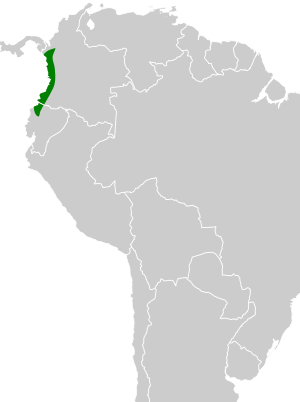Chocó poorwill facts for kids
Quick facts for kids Chocó poorwill |
|
|---|---|
| Conservation status | |
| Scientific classification | |
| Genus: |
Nyctiphrynus
|
| Species: |
rosenbergi
|
 |
|
| Synonyms | |
|
|
The Chocó poorwill (Nyctiphrynus rosenbergi) is a fascinating bird that flies mostly at night. It belongs to a family of birds called nightjars. You can find this special bird living in the humid forests of Colombia and Ecuador.
Contents
What is a Chocó Poorwill?
The Chocó poorwill was first described in 1895. For a while, people thought it might be a type of ocellated poorwill. But scientists studied its feathers, calls, and even its DNA. They found that the Chocó poorwill is actually its own unique species. This means it is a distinct type of bird, not just a variation of another.
What Does a Chocó Poorwill Look Like?
This interesting bird is about 19.5 to 22.5 centimeters (around 7.5 to 9 inches) long. One female bird weighed about 52 grams (less than 2 ounces). Adult Chocó poorwills are mostly dark brown.
Their heads are grayish with many black spots. Their backs are grayish with speckles of cinnamon and reddish-brown. The lower back is browner with grayish-white spots. Their wings are brown to dark brown. They have tawny, cinnamon, and reddish-brown spots. You can also see two clear white spots on their wings.
The chin is dark brown with cinnamon speckles. The throat has a large white patch. The chest is brown with cinnamon bars and speckles. The belly and sides are blackish-brown with thin grayish-white bars. Young Chocó poorwills look similar to adults. However, they do not have the two white spots on their wings. Their back and chest markings are also more reddish-brown.
Where Do Chocó Poorwills Live?
The Chocó poorwill lives along the Pacific coast. Its home stretches from northern Colombia's Chocó Department down into Ecuador's Esmeraldas Province. It might even live further south.
This bird prefers a very wet evergreen forest environment. This area is known as the Pacific/Chocó natural region. Chocó poorwills seem to like the edges of these forests. You might find them along rivers or in open areas where trees have fallen. They live from sea level up to about 900 meters (nearly 3,000 feet) high.
How Do Chocó Poorwills Behave?
Hunting for Food
Chocó poorwills are active during twilight (dawn and dusk) and at night. This means they are crepuscular and nocturnal hunters. They have been seen catching insects in a few ways. Sometimes, they fly out from the ground or a branch to grab an insect. Other times, they fly continuously above the treetops to find food. We know they eat insects, but scientists are still learning more about their exact diet.
Raising Young
Not much is known about how Chocó poorwills raise their young. Like other birds in their family, they probably lay one or two eggs. They likely lay these eggs directly on the ground. Scientists believe their breeding season is from March to June.
What Sounds Do They Make?
The song of the Chocó poorwill is quite special. It is described as a clear, whistling sound. It sounds like a rhythmic "kwor kwor kwor kweeér." They also make sounds that are like a frog's croak. These include notes like "kwok" or "kwi-kwok," and a "klaw."
Is the Chocó Poorwill in Danger?
The IUCN (International Union for Conservation of Nature) has listed the Chocó poorwill as a species of "least concern." This means it is not currently considered to be highly endangered. However, we do not know the exact number of these birds. Scientists believe their population is decreasing. This is mainly because of deforestation. Forests are being cut down for new settlements, to grow oil palm trees, and for other uses. This loss of habitat is a big problem for the Chocó poorwill.
Images for kids
See also
 In Spanish: Nyctiphrynus rosenbergi para niños
In Spanish: Nyctiphrynus rosenbergi para niños



